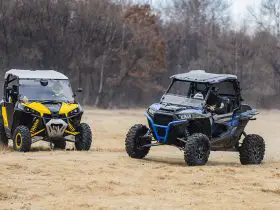5.000 miles can be considered as high mileage for a UTV. With good maintenance and service, a UTV can last for thousands of miles. There is no exact number of how many miles and how long your UTV can last. It is really a matter of many factors like service intervals and driving style.
On any given day of the life of an off-road vehicle such as a UTV, longevity depends on how it is maintained and how hard it is ridden. We say this because this vehicle is built exactly for the purpose of what it was made for, a rough and adventurous ride. And, that’s how it is likely going to be handled. Otherwise, it wouldn’t be fun, would it?
We enjoy these recreational inventions the way they should be enjoyed, with some intensity and a little bit of abandon. Just follow the maintenance process and it could give you countless hours, and accumulated thousands of miles of excitement and satisfaction. Great! Bu the question is…
It could be the environment (desert, swampy, etc.), how hard the driver rides, and how much maintenance he does Of course, we are only referring to the core of this vehicle which is the engine. Nevertheless, there are many possible answers to this question as based on sources of real owners of UTVs.
Table of Contents
What owners say about their milage
Polaris XP 900 (at 3,500 miles)
The owner started having some issues at 3,500 miles. This unit was ridden hard by the owner with the motor running at high RPM the whole day.
Can-Am Commander 1000 (at 3,400 miles)
At 3,400 miles this UTV is still running fine says the owner.
Can-Am Maverick X ds Turbo 2015 (at 4,700 miles)
The unit was losing 1000 rpm at 450 hours and 4,700 miles. This is when she found out that a branch of berries was sucked in the air intake in front of the air filter.
Can-Am Commander Max (at 6,000 miles)
At 6,000 miles this unit still has no problems and still runs like it was new.
And the list goes on…
Type of Miles and Driving Style does Matters
So, the disparity among real-life results is fairly obvious. Whenever you are thinking of buying a UTV, you might want to take into consideration whether it is brand new or is it used? (Read article Tips When Buying a Used UTV) Where it was operated? Was it regularly maintained?
A thousand hours spent on a farm in Nebraska by an owner that did regular maintenance is totally different from 1000 hours spent on the rough trails of the Appalachians. And, possibly may have been owned by a person who might have rarely changed the fluids on the unit. Tough as these machines are, hard riding on demanding terrain and rough trails is going to cause accelerated wear and tear on the vehicle.
So when your UTV starts having issues, you get to the next best option, rebuild.
Top End Rebuild
Top end rebuilds on an engine means literally rebuilding the top portion of your engine. The top end components are as follows:
• Valve guides
• Replace valves
• Valve springs
• Piston
• Cylinders
• Rings
• Crank bearings
• Cylinder head housing
This process involves restoring the engine to essentially new conditions by machining and replacing internal parts to its original state. It could even convert some of the parts into better specifications. This process is usually done by a qualified mechanic who specializes in rebuilding the top end of engines.
So, if you are thinking about the possibility that your engine might already be having issues, you can always take it to the nearest trusted machine shop and have it done for you. This doesn’t come cheap though, as it depends on the parts that need replacing.
Upgrade Kits
There are some UTV manufacturers such as Polaris that offer upgrade kits. According to them, it not only restores your engine to brand new but also produces an additional 6 horsepower. The kit contains valve springs, gaskets, camshaft, gaskets, primary clutch weights, clutch springs, and so forth. This kit and its components are not the ordinary kits that you can do yourself, as it requires a reflash from the dealer.
You would have to visit the dealer to have them professionally installed and reflashed. Seemingly though, it actually delivers more horsepower than what the manufacturer is promising. Some positive feedback from customers include that they can “feel”, the engine pulling power from the bottom all the way to the top.
You can feel the most improvement where the UTV goes through a loose trail and holds steady without losing momentum. It can even accelerate at any time it needs to.
How to Know When It’s Time to Rebuild Your Top End
1) Prevention
Preventing your engine from prematurely going bad is always the best option. Just go ahead and perform routine maintenance such as oil check and oil replacement. Synthetic oil is by the way recommended for newer engines. Do not use ordinary motor oil as it’ll damage your engine. Use only special oils for UTV.
2) Signs When It’s Time to Rebuild
• The motor stops running while emitting a large black smoke.• Try to do a rebuild even before smoke happens.
• When the unit may have been hard-used you can replace its pistons every after 50 hours of riding.
• Using a magnetic drain plug to attract metal pieces and find more than you should be seeing.
• Unit is hard starting.
3) Find a Trusted Mechanic
Going to your official dealer is always the best option.
4) Find Out the Cost of the Rebuild
Get a real estimate upfront before any work gets done.
5) Know Which Replacement is Needed
Modern valves don’t need as much replacement as often as your pistons.
6) Know which are original equipment parts and aftermarket parts
You may be surprised to know that aftermarket parts cost less than the original equipment parts. Though there are some parts that you can only find at your dealer.
7) Know which Are the Rebuilt Parts
You can check your locality for a trusted seller of rebuilt parts. Call by phone if you must.
8) Know When to Sell
Try to be honest with your price as to the real value of your rig. If it still runs well, then adjust your price accordingly. You can also check for the going price on eBay.
The CVT Belt of Your UTV
CVT belt or continuous variable transmission belt is one of the more known parts that you need to watch out for. Apart from your pistons and wheels, a CVT belt is a belt designed and used for an automatic transmission. It allows for your UTV to change gears seamlessly. Read more How UTV Clutches and Transmissions Work.
It is made out of flexible material which is composed of thin bands of steel that keep together high-strength pieces of metal. On a normal mode these belts typically last for 5 years. However, in the UVT world this spare part gets worn out much sooner.
This is due to the nature of UVT sport that usually rides this belt hard. It is important to keep a spare one whenever you are on the road. And also, you would want to monitor it as you go along to make sure it doesn’t snap on you somewhere you might be negotiating a small pass, or maybe at the edge of a cliff.
How To Know if Your CVT Belt is About to Break
Here is how you can check your CVT belt for safety and possible replacement.
0 miles / Unused
It is a unused, brand new belt. Look to the underside right between the bumps, if the fabric is deteriorating the belt might be defective. Prior to replacing with a new belt make sure to wash it with warm soap and water.
500 miles (800 km)
If this belt was not hard-used at this mileage. The fabric material should still be in good condition. No need to change it. It can still be used as a good spare.
1.000 miles (1.600 km)
At this mileage, assuming that the unit was hard-used, it would show signs of wear and tear, and also some signs of breaking. Make sure to replace it immediately. Prevent incidental belt failure by easing up on the throttle instead of flooring it.
3.000+ miles (4.800+ km)
At this distance, the belt by now should show signs of extreme wear and tear. It should be replaced immediately and not be used as a spare.
How to Make Your UTV Last Longer
More often than not, any owner of a UTV would like their units to last longer than its usual service life. The good thing is, there are some things we can do to make it happen.
Air Filters
Just like any other engine that relies on combustion to run, it needs the proper amount of air to burn fuel. With that in mind, do, take care to maintain your air filter so that it remains unclogged. Otherwise, you’ll risk your engine “running rich” and putting on unnecessary strain, thereby shortening your spark plug’s life. Make sure your filter is properly sealed to prevent the air filter from leaking.
Belts
Standard with UTVS nowadays is CVT belts. And it is important to keep it cool and dry. If you go into the water, it can cause the transmission to slip, which could create belt damage. Just in case this happens, make sure to drain the CVT box.
Axle Boots
CV axle boots may receive normal wear and tear during the course of operating your UTV in rough trails. It protects the front and rear velocity joints. So the harder you ride the faster it wears out. Elements like water, mud, debris may also hasten its expiry. A reasonable amount of caution when driving your UTV could potentially increase your axle boots’ service life.
Overall, the life expectancy of your UTV engine, frame, and its other critical components largely depends on how you care for it. Now if you are a hard rider who likes adventure, then be at least prepared to shell out more than you would for replacement parts. These are to be replaced as soon as possible to avoid the domino effect on other parts. Enjoy the drive.









